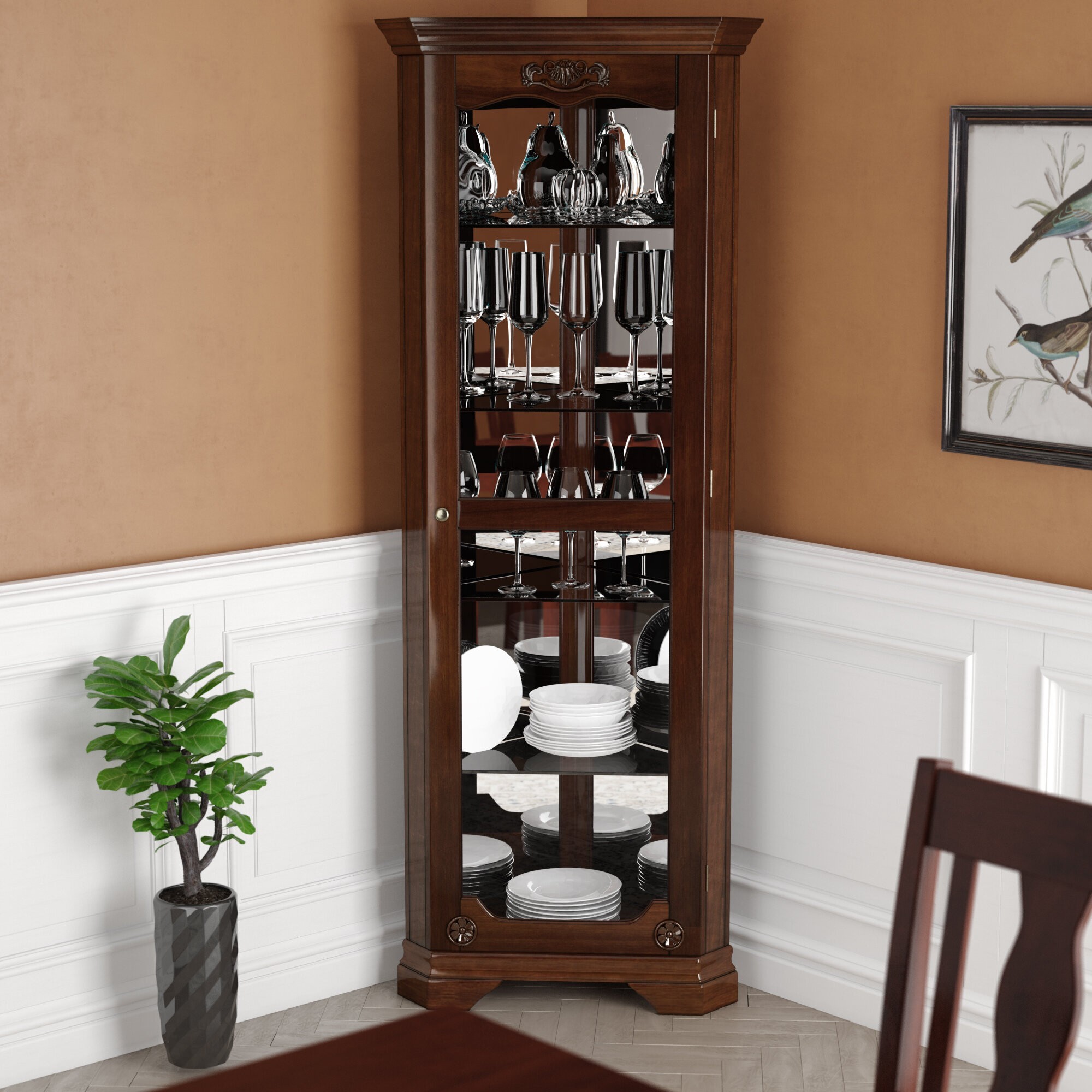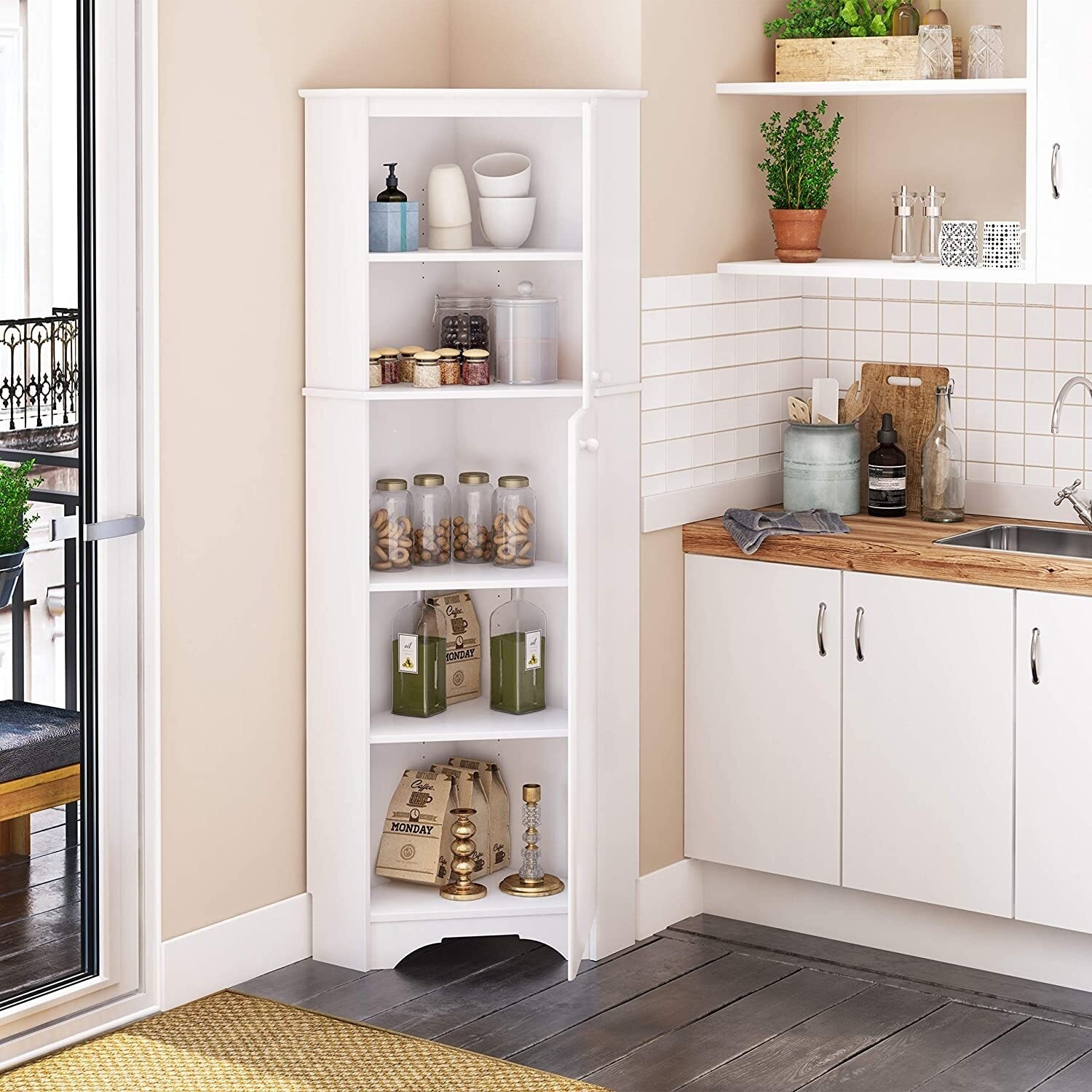Corner Cabinet Styles & Design: Corner Cabinet Furniture For Living Room

Corner cabinets offer a stylish and practical solution for maximizing storage in living rooms, particularly in smaller spaces. Their strategic placement allows for efficient use of often-underutilized corners, enhancing both functionality and aesthetics. The choice of style and materials significantly impacts the overall look and feel of the room.
Corner Cabinet Styles
Choosing the right corner cabinet style depends heavily on the existing decor and desired ambiance of your living room. The following table details five popular styles, highlighting their design features and suitability for different room aesthetics.
| Style Name | Key Features | Suitable Room Style | Image Description |
|---|---|---|---|
| Traditional | Ornate detailing, often made from dark wood, featuring multiple doors and drawers, possibly with glass panels. | Classic, Victorian, Traditional | A dark mahogany corner cabinet with detailed carvings, multiple paneled doors, and brass hardware. The cabinet sits slightly elevated on small, turned legs. |
| Modern | Clean lines, minimalist design, often made from lighter woods or lacquered finishes, with sleek handles or recessed pulls. | Modern, Contemporary, Minimalist | A sleek, white lacquered corner cabinet with integrated shelving and simple, flush-mounted handles. The cabinet features a seamless, uncluttered design. |
| Shaker | Simple, functional design, typically made from light-colored wood, with flat panel doors and minimal ornamentation. | Farmhouse, Rustic, Shaker | A light-colored wood corner cabinet with simple, flat-panel doors and understated hardware. The cabinet has a clean, uncluttered appearance. |
| Mission | Straight lines, sturdy construction, typically made from dark wood, featuring strong horizontal and vertical lines. | Mission, Arts & Crafts, Rustic | A dark stained wood corner cabinet with strong horizontal and vertical lines, simple metal hardware, and a substantial feel. |
| Eclectic | Combines elements from different styles, often using a mix of materials and colors, featuring unique details and a personalized touch. | Eclectic, Bohemian, Global | A corner cabinet incorporating mixed materials such as reclaimed wood, metal accents, and glass shelves, showcasing a blend of styles and textures. |
Traditional vs. Modern Corner Cabinets
Traditional corner cabinets typically feature multiple doors and drawers, offering ample storage but sometimes lacking organization. Modern corner cabinets, especially those with integrated shelving, prioritize both storage and accessibility. The integrated shelving allows for customized organization, making items easily visible and accessible, unlike the often-hidden storage of traditional designs. Modern designs frequently incorporate innovative space-saving features like pull-out shelves and hidden compartments.
Materials and Their Impact
The choice of materials significantly affects both the aesthetic and durability of a corner cabinet. Solid wood (oak, cherry, mahogany) provides classic elegance and durability but comes at a higher cost. Engineered wood (MDF, plywood) offers a more affordable alternative, though it may not be as long-lasting. Glass doors add visual appeal and allow for showcasing decorative items. Metal accents, such as handles and frames, can add a contemporary or industrial touch, while also contributing to durability.
Space-Saving Corner Cabinet Layouts for Small Living Rooms
Maximizing space in a small living room requires thoughtful planning. Here are three corner cabinet layout ideas emphasizing space-saving techniques:
Corner cabinet furniture for living room – Layout 1: A tall, narrow corner cabinet reaching almost to the ceiling maximizes vertical space. Shallow shelves are ideal for storing books and smaller items, while the lower section can accommodate larger items.
Layout 2: A multi-functional corner unit combining a cabinet with a built-in seating area. The cabinet provides storage, while the seating offers additional seating in a compact space.
Layout 3: Two smaller corner cabinets placed strategically to form an L-shape, utilizing the corner effectively while maintaining a balanced aesthetic. One cabinet could house electronics, while the other could store books and media.
Corner Cabinet Placement & Functionality

Corner cabinets offer a unique opportunity to maximize storage and enhance the aesthetic appeal of a living room. Their strategic placement and thoughtful design can significantly impact the overall functionality and flow of the space. Careful consideration of size, shape, and lighting integration is crucial for optimal results.
Strategic placement of corner cabinets is key to maximizing their functionality and aesthetic contribution to your living room. Different locations offer unique advantages and disadvantages depending on your room’s layout and your specific needs.
Corner Cabinet Placement Strategies
The ideal placement of a corner cabinet depends heavily on the existing layout of your living room. Here are a few common placement strategies, along with their pros and cons:
- Near a Fireplace:
- Pros: Creates a visually balanced focal point, provides convenient storage for fireplace accessories (e.g., logs, kindling, tools), adds warmth and character to the space.
- Cons: May require heat-resistant materials if placed very close to the fireplace, could obstruct access to the fireplace or interfere with its aesthetic appeal if improperly sized or placed.
- Under a Window:
- Pros: Maximizes natural light, provides ample storage for books or decorative items, can create a cozy reading nook.
- Cons: May block some natural light if too large, might interfere with window treatments (e.g., curtains, blinds), requires careful measurement to ensure a proper fit.
- In a Corner Alcove:
- Pros: Seamlessly integrates into existing architectural features, creates a defined area for storage, can enhance the room’s architectural interest.
- Cons: Limited flexibility in size and design due to the alcove’s dimensions, may require custom-built cabinetry to fit perfectly.
Enhancing Living Room Storage with Corner Cabinets, Corner cabinet furniture for living room
Corner cabinets are exceptionally versatile storage solutions. Their design allows them to hold a variety of items efficiently, maximizing space utilization. Clever organization within the cabinet is essential to fully leverage this storage potential.
Books, media, and decorative objects can be efficiently organized within corner cabinets. Using adjustable shelves allows for customization based on item size and quantity. Dividers can separate books, media, and decorative items. Clear containers can be used to store smaller items and maintain a visually appealing interior.
Selecting the Right Size and Shape
Choosing the appropriate size and shape of a corner cabinet is crucial for both functionality and aesthetics. The available space and the intended use of the cabinet will dictate the best dimensions.
Consider the following factors: the available floor space, the height of the ceiling, the overall style of your living room, and the types of items you plan to store. A smaller cabinet might suffice for a smaller living room, while a larger, more elaborate cabinet could complement a spacious living room.
| Living Room Size (sq ft) | Ideal Corner Cabinet Dimensions (W x D x H) |
|---|---|
| Under 200 | 36″ x 36″ x 72″ |
| 200-400 | 48″ x 48″ x 78″ |
| Over 400 | 60″ x 60″ x 84″ |
Note: These are suggested dimensions; actual ideal dimensions will vary based on specific room layouts and personal preferences. Measurements should always be taken to ensure a proper fit.
Lighting Integration in Corner Cabinet Designs
Incorporating lighting into corner cabinet designs can dramatically enhance their functionality and aesthetic appeal. Well-placed lighting can highlight decorative items and provide ambient room lighting, adding depth and dimension to the space.
- Recessed LED Lighting: Small, energy-efficient LED lights can be recessed into the cabinet’s shelves, providing subtle illumination for displayed items. This minimizes glare and creates a soft, ambient glow.
- Under-Cabinet Lighting: LED strip lights installed beneath the cabinet’s base can illuminate the surrounding area, creating a warm and inviting atmosphere. This is particularly effective in darker corners.
- Glass-Front Cabinets with Interior Lighting: Glass-fronted cabinets allow for the display of decorative items. Installing interior lighting within these cabinets showcases the contents, adding a touch of elegance to the living room.
Corner Cabinet Selection & Maintenance

Choosing the perfect corner cabinet for your living room involves careful consideration of several factors. Finding the right balance between budget, aesthetic appeal, and practical storage solutions is key to a successful purchase and a beautifully organized space. This section will guide you through the selection process and provide essential maintenance tips to ensure your corner cabinet remains a stylish and functional addition to your home for years to come.
Selecting the right corner cabinet requires a thoughtful approach. Consider your budget, desired style, and the specific storage needs of your living room. Do you need ample space for books and media, or are you looking for a more discreet solution to store smaller items? Understanding your needs will significantly narrow down your options. Different styles, from traditional to modern, offer unique aesthetic qualities and storage configurations. Matching your chosen cabinet to your existing living room décor will ensure a cohesive and visually pleasing environment.
Choosing a Corner Cabinet Based on Budget, Style, and Storage Needs
Budget significantly influences the materials and features available. Entry-level cabinets often use particleboard or MDF, while higher-end options may utilize solid wood or high-quality veneers. Style preferences range from classic designs with ornate details to sleek, minimalist styles that complement contemporary décor. Storage needs should dictate the size and internal configuration of the cabinet. Consider the number of shelves, drawers, and the overall capacity needed to accommodate your belongings. For instance, a family with a large media collection would require a cabinet with more substantial shelving than someone with minimal storage needs.
Key Features to Consider When Buying a Corner Cabinet
Before making a purchase, carefully evaluate these five key features:
- Material: The material significantly impacts durability, aesthetics, and price. Solid wood offers superior longevity and a classic look, while MDF or particleboard are more budget-friendly but less durable. Consider the expected lifespan and your budget when making this decision. For example, a solid oak cabinet will be significantly more expensive than one made from particleboard, but it will also likely last much longer.
- Construction: Examine the joinery and overall build quality. Strong joints, sturdy hinges, and smooth-gliding drawers are indicators of a well-constructed cabinet. Look for cabinets with dovetail joints or other robust construction techniques for increased durability.
- Storage Capacity: Measure your available space and estimate your storage needs. Consider the number of shelves, drawers, and their depth to ensure sufficient storage for your items. A poorly planned purchase can lead to insufficient storage or wasted space.
- Assembly: Determine whether the cabinet requires assembly. Ready-to-assemble (RTA) cabinets are generally more affordable, but they require time and effort to put together. Pre-assembled cabinets are more convenient but come with a higher price tag.
- Warranty: A good warranty indicates the manufacturer’s confidence in the quality of their product. Check the warranty terms and conditions before purchasing to understand what is covered and for how long.
Cleaning and Maintaining Different Corner Cabinet Materials
Proper cleaning and maintenance are crucial for extending the lifespan of your corner cabinet. The method varies depending on the material:
- Wood: Dust regularly with a soft cloth. For cleaning, use a slightly damp (not wet) cloth with mild soap and water. Avoid harsh chemicals and abrasive cleaners. Polish periodically with a suitable wood polish to maintain the finish and protect against damage. Always test any cleaning product on a hidden area first to ensure it doesn’t damage the finish.
- MDF/Particleboard: Dust regularly with a soft cloth or a slightly damp cloth. Avoid excessive moisture as it can damage the material. Use a mild cleaner if needed. Avoid abrasive cleaners and scouring pads.
- Laminate: Laminate is relatively easy to clean. Wipe with a damp cloth and mild soap. Avoid harsh chemicals and abrasive cleaners. For stubborn stains, use a glass cleaner or a multi-purpose cleaner suitable for laminate surfaces.
- Metal: Metal cabinets can be cleaned with a damp cloth and mild soap. For tougher stains, use a metal polish. Avoid abrasive cleaners and scouring pads.
- Glass: Glass requires regular dusting and can be cleaned with glass cleaner and a soft cloth. Avoid harsh chemicals or abrasive materials.
